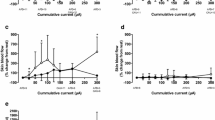Summary
-
1.
Blood flow was measured in the brood patch of Bantam hens by recording the washout of133Xe from the tissue in different experimental conditions.
-
2.
In hens incubating 5 eggs at normal temperature, cutaneous and subcutaneous blood flow in the brood patch averaged 0.31 ml·min−1·g−1 and 0.15 ml·min−1·g−1, respectively.
-
3.
Cooling the brood patch in restrained hens immediately increased cutaneous and subcutaneous blood flow by an average of 83% and 63%, respectively. The increase in blood flow was restricted to the site of cooling, while neighbouring skin areas showed little change in flow. This cold vasodilatation could also be elicited in hens incubating water circulated eggs and was unaffected by local anaesthetics.
-
4.
The observations suggest that the vasodilatation in response to cooling is due to a direct temperature influence on the smooth muscle cells of the brood patch vasculature.
-
5.
It is suggested that the cold vasodilatation may be important for providing increased heat transfer to the eggs at low ambient temperatures or when the parent bird returns to cool eggs after feeding excursions.
Similar content being viewed by others
References
Bailey RE (1952) The incubation patch of passerine birds. Condor 54:121–136
Biebach H (1979) Energetik des Brütens beim Star (Sturnus vulgaris). J Ornithol 120:121–138
Drent RH (1970) Functional aspects of incubation in the Herring gull. Behaviour [Suppl] 17:1–132
Drent R (1975) Incubation. In: Farner DS, King JR (eds) Avian biology, vol 5. Academic Press, New York, pp 333–420
Folkow B, Fox RH, Krog J, Odelram H, Thorén O (1963) Studies on the reactions of cutaneous blood vessels to cold exposure. Acta Physiol Scand 58:342–354
Gabrielsen G, Steen JB (1979) Tachycardia during egg-hypothermia in incubating ptarmigan (Lagopus lagopus). Acta Physiol Scand 107:273–277
Greenfield ADM, Shepherd JT, Whelan RF (1951) The part played by the nervous system in the response to cold of the circulation through the finger tip. Clin Sci 10:347–360
Haftorn S (1979) Incubation and regulation of egg temperature in the Willow titParus montanus. Ornis Scand 10:220–234
Haftorn S, Reinertsen RE (1982) Regulation of body temperature and heat transfer to eggs during incubation. Ornis Scand 13:1–10
Hales JRS (1985) Skin arteriovenous anastomoses, their control and role in thermoregulation. In: Johansen K, Burggren WW (eds) Cardiovascular shunts. Munksgaard, Copenhagen
Henriksen O (1977) Local sympathetic reflex mechanism in regulation of blood flow in human subcutaneous adipose tissue. Acta Physiol Scand [Suppl] 450:1–48
Hillman PE, Scott NR, van Tienhoven A (1982) Vasomotion in chicken foot: dual innervation of arteriovenous anastomoses. Am J Physiol 242:R582-R590
Irving L, Krog J (1956) Temperature during the development of birds in arctic nests. Physiol Zool 29:195–205
Johansen K, Millard RW (1974) Cold-induced neurogenic vasodilatation in skin of the Giant fulmarMacronectes giganteus. Am J Physiol 227:1232–1235
Jones RE (1969) Hormonal control of incubation patch development in California quailLophortyx californicus. Gen Comp Endocrinol 13:1–13
Kety SS (1948) Quantitative measurement of regional circulation by clearance of sodium. Am J Med Sci 215:352–353
Krog J, Folkow B, Fox RH, Lange Andersen K (1960) Hand circulation in the cold of Lapps and Norwegian fishermen. J Appl Physiol 15:654–658
Lange B (1928) Die Brutflecke der Vögel und die für sie wichtigen Hauteigentümlichkeiten. Gegenbaurs Morph Jb 59:601–712
Larsen OA, Lassen NA, Quaade F (1966) Blood flow through human adipose tissue determined by radioactive xenon. Acta Physiol Scand 66:337–345
Lewis T (1930) Observations upon the reactions of the vessels of the human skin to cold. Heart 15:177–208
McGregor DD (1979) Noncholinergic vasodilator innervation in the feet of ducks and chickens. Am J Physiol 237:H112-H117
Midtgård U (1984) Density of arteriovenous anastomoses in some skin areas of the domestic fowl (Gallus domesticus). Anat Rec 209:455–459
Molyneux GS, Harmon B (1982) Innervation of arteriovenous anastomoses in the web of the foot of the domestic duck,Anas platyrhynchos. Structural evidence for the presence of non-adrenergic non-cholinergic nerves. J Anat 135:119–128
Murrish DE, Guard CL (1977) Cardiovascular adaptations of the Giant petrel,Macronectes giganteus, to the antarctic environment. In: Llano GA (ed) Adaptations within antarctic ecosystems. Smithsonian Institute, Washington, pp 511–530
Sejrsen P (1968) Atraumatic local labelling of skin by inert gas: epicutaneous application of xenon-133. J Appl Physiol 24:570–572
Sejrsen P (1969) Blood flow in cutaneous tissue in man studied by washout of radioactive xenon. Circulation Res 25:215–229
Sejrsen P (1971) Measurement of cutaneous blood flow by freely diffusible radioactive isotopes. Danish Med Bull [Suppl] 18:1–38
Sturkie PD (1976) Avian physiology. Springer, Berlin Heidelberg New York, pp 1–400
Tøien Ø (1984) Rugefysiologi: Respons på varierende eggtemperatur hos rugende dverghøner. Thesis, University of Oslo, pp 1–61
Tøien Ø, Aulie A, Steen JB (1984) Physiological responses in bantams incubating cold water circulated eggs. Fauna Norvegica Ser C. cinclus 7:138
Vleck CM (1981) Energetic cost of incubation in the zebra finch. Condor 83:229–237
White FN, Kinney JL (1974) Avian incubation. Science 186:107–115
Winquist RJ, Bevan JA (1980) Temperature sensitivity of tone in the rabbit facial vein: Myogenic mechanism for cranial thermoregulation. Science 207:1001–1002
Wolfenson D, Frei YF, Snapir N, Berman A (1981) Heat stress effects on capillary blood flow and its redistribution in the laying hen. Pflügers Arch 390:86–93
Yeh S-Y, Peterson R (1963) Solubility of carbon dioxide, krypton, and xenon in lipids. J Pharmacol Sci 52:453–458
Yeh S-Y, Peterson R (1964) Solubility of carbon dioxide, krypton, and xenon in aquous solutions. J Pharmacol Sci 53:822–824
Yeh S-Y, Peterson R (1965) Solubility of krypton and xenon in blood, protein solutions, and tissue homogenates. J Appl Physiol 20:1041–1047
Author information
Authors and Affiliations
Rights and permissions
About this article
Cite this article
Midtgård, U., Sejrsen, P. & Johansen, K. Blood flow in the brood patch of Bantam hens: evidence of cold vasodilatation. J Comp Physiol B 155, 703–709 (1985). https://doi.org/10.1007/BF00694584
Accepted:
Issue Date:
DOI: https://doi.org/10.1007/BF00694584




